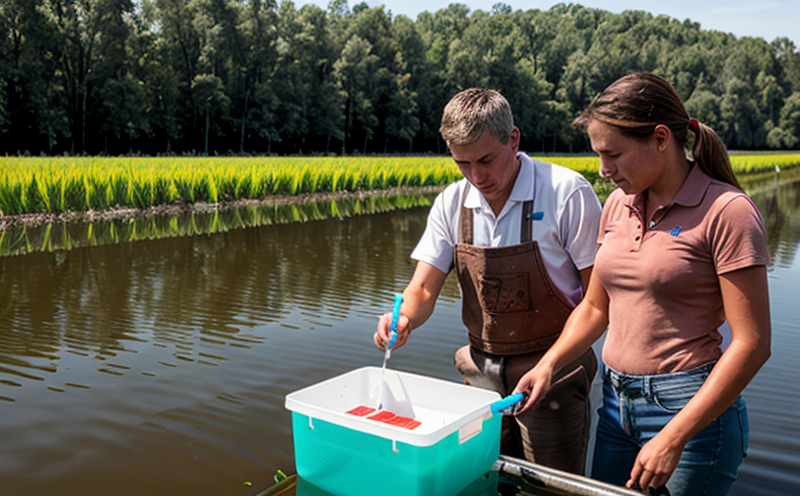Organic Pollutants Testing in Irrigation Water
The testing of organic pollutants in irrigation water is crucial for ensuring that agricultural practices do not degrade soil or harm crops. Organic pollutants, including pesticides, herbicides, and other chemical residues, can accumulate in the environment if not properly managed. This contamination can lead to a variety of issues such as reduced crop yields, increased susceptibility to diseases, and environmental damage.
Understanding the presence and levels of these pollutants is essential for farmers, quality managers, and compliance officers. By identifying and quantifying organic pollutants early on, corrective measures can be taken to mitigate their impact. This testing involves a series of steps that include sampling, sample preparation, analysis using advanced instrumentation such as gas chromatography-mass spectrometry (GC-MS), and interpretation of results.
The first step in this process is the collection of representative samples from various points within the irrigation system. These samples should be collected at different times to capture variations throughout the day or week. Once collected, the samples undergo thorough preparation which may include filtration and dilution steps depending on the concentration levels expected. The analytical methods used for identifying organic pollutants are highly sensitive and specific ensuring accurate quantification.
The primary goal of this testing is not only detection but also understanding how different chemicals interact within the irrigation system and with crops being grown under these conditions. Compliance officers need reliable data to ensure they meet regulatory requirements set forth by organizations like the Environmental Protection Agency (EPA), Food and Drug Administration (FDA), or relevant international standards such as ISO 17025.
Agricultural water systems are complex ecosystems where numerous variables influence pollutant behavior including pH levels, temperature fluctuations, and types of crops grown. Understanding these factors helps in designing more effective sampling strategies and interpreting results correctly. For instance, certain pesticides may behave differently when applied to sandy soils compared to clayey ones due to varying adsorption properties.
In conclusion, organic pollutants testing is an integral part of sustainable agricultural practices aimed at protecting both human health and the environment from potential harm caused by improper use or disposal of chemicals in irrigation systems. By implementing regular monitoring programs based on scientifically validated methodologies, stakeholders can make informed decisions about their operations thereby promoting long-term sustainability.
| Sample Type | Target Pollutants | Testing Methodology |
|---|---|---|
| Irrigation Water | Pesticides, Herbicides, Heavy Metals | GC-MS, HPLC |
| Crop Runoff | Nitrogen Compounds, Phosphates | AAS, ICP-OES |
Benefits
- Ensures compliance with local and international regulations.
- Promotes sustainable agricultural practices by minimizing environmental impact.
- Improves crop quality and yield through optimized irrigation management.
- Reduces risks associated with contaminated produce for consumers.
- Aids in identifying sources of pollution allowing targeted remediation efforts.
Industry Applications
This service finds significant application across various sectors within agriculture and forestry, particularly where efficient use of water resources is critical. Farmers who rely heavily on irrigation systems benefit greatly from this testing as it helps them maintain optimal conditions for their crops while reducing the risk of contaminating nearby ecosystems.
| Industry Sector | Main Application |
|---|---|
| Farmers | Monitoring and managing pesticide residues in irrigation water. |
| Agricultural Supply Chains | Evaluating the quality of water used for processing food products. |
| Environmental Agencies | Assessing impacts on local water bodies due to agricultural activities. |
The data obtained from organic pollutants testing can also be utilized during research projects focused on developing new, safer alternatives for pest control or fertilizer applications. Additionally, this information supports the design of better irrigation systems capable of handling diverse environmental conditions effectively.
Quality and Reliability Assurance
- Our laboratory adheres strictly to ISO 17025 standards ensuring accuracy and precision in all tests conducted.
- All analysts undergo rigorous training programs focusing on the latest techniques used in organic pollutant analysis.
- We use state-of-the-art equipment calibrated regularly according to manufacturer guidelines to maintain reliability throughout each test cycle.
- Data integrity is maintained through strict quality control measures implemented at every stage of sample processing and analysis.
These rigorous practices ensure that our clients receive dependable results they can trust when making important decisions regarding their agricultural operations. Compliance officers will find this level of assurance particularly valuable as it supports regulatory compliance initiatives aimed at protecting public health and the environment.





